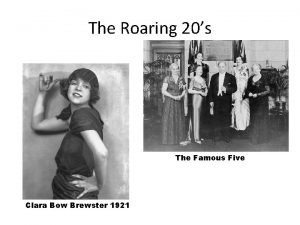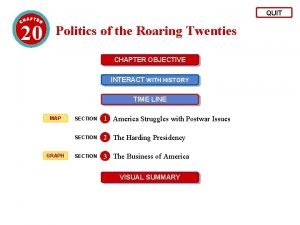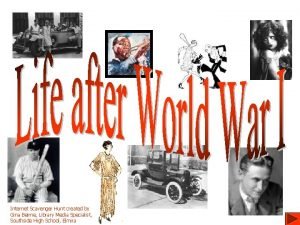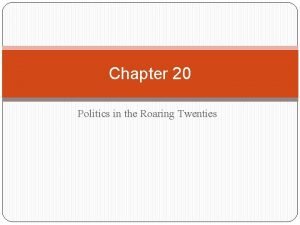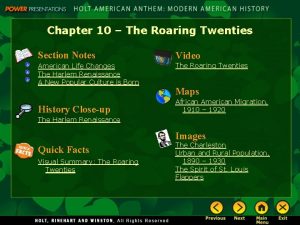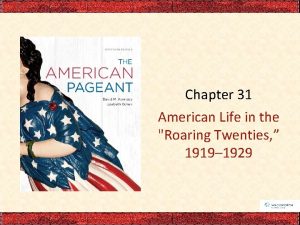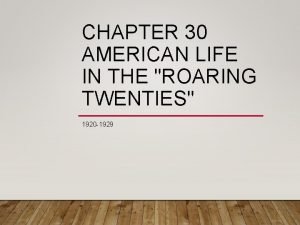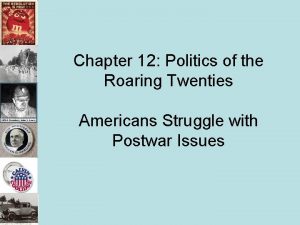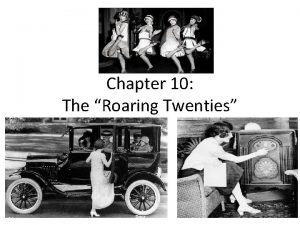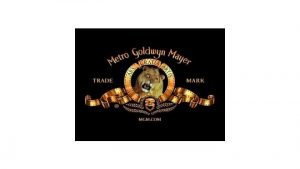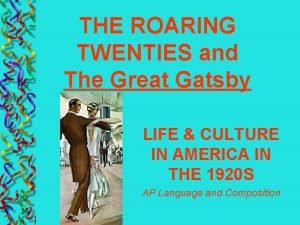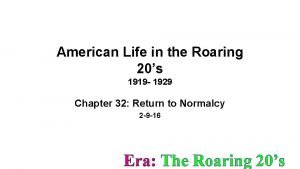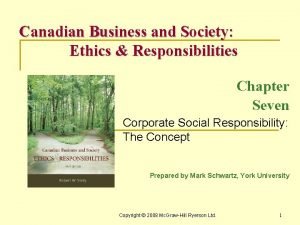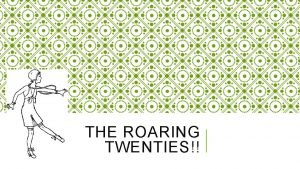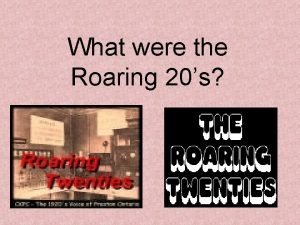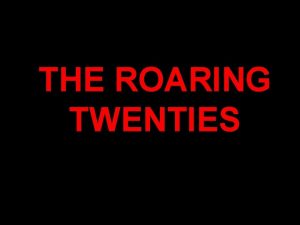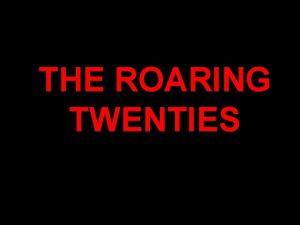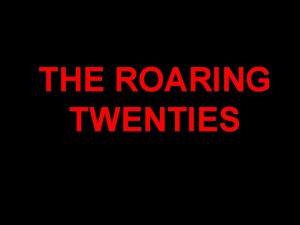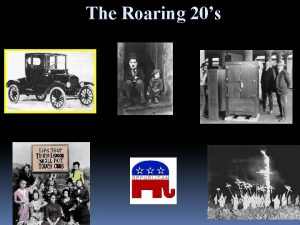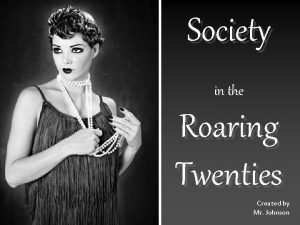THE ROARING TWENTIES Canadian Society and Culture in
















- Slides: 16

THE ROARING TWENTIES Canadian Society and Culture in the 20’s Slides originally by S. Cassidy

Post War Adjustment � � � End of war was cause for celebration Returning soldiers faced obstacles: �Some waited years to be shipped home �hard time re-adjusting to a peacetime society ▫ Depression �Wanted compensation for their pain and suffering ▫ more money supplied in pensions and other payments Country torn in two by conscription �resentment lasted generations


Hi This is my Grandfather Allan Joyce on his wedding at the end of the war. His hands are behind him because he lost several fingers during the war. He has a glass eye and the glasses help hide some of the scars along with vision loss. He has shrapnel in his head and various parts of his body that was never removed. He also had some leg damage. You will notice though that it is mostly his hands he hides due to most of the damage. I believe he was in Ypres. He was blown up, left for dead , thrown in a wagon they used to haul the dead and if under a pile of bodies he had not moved his toes and someone saw him he would have been buried with the dead. He only ever mentioned the shrapnel to me when I was little and asking questions about the glass eye and injuries. Like many WWI vets he was an active Legion member. I believe he also suffered from some shell shock after the war. His wife came from a "better " family ( Sarah Lawrence and they were rather distressed when she fulfilled her promise to marry him as he was quite damaged after the war and they were worried how he would earn income etc. The other photos is my Grandfather with his family including my Mother. His wife had died of diabetes a few years before. The guys are James and Larry Joyce who were involved along with other battles in the emancipation of Holland. They survived the war and went on to become successful businessmen. My Husband tells me that his grandfather had his lungs damaged by gas in the first world war. He came back looking physically able. However he found it hard to do hard farm work. He could not get the air for it and was physically weaker. My husbands grandmother came from a hardworking farm family and men who could not work hard physically on the farm did not do well in a farming life after the war. He had to return to his family in England to have them help raise some his children and find another kind of work. My husbands Mother and Grandmother were left on the farm in Canada. I think you will find this discrimination about men damaged by the gas as a rampant thing after the war and people not understanding why they could not work hard. It was up there with the lack of understanding around shell shock. . Just a bit of FYI for thanksgiving. . to remember people who are not anonymous faces of the war. . L. Tatomir (previous staff at SJB)

Why were the 20’s “Roaring”? � Economic boom – resulting from the war � Canadians � Misery of war was over � Society � � could afford more luxuries and leisure time generally optimistic People enjoyed new forms of entertainment General feeling of overindulgence characterized the decade

Increased Mobility � � � Automobiles were changing the landscape Cars being produced more quickly and becoming cheaper �By late 20’s – 50% of homes had an auto. More and better roads constructed – easier travel

Suburbs � � � Automobile enabled growth of suburbs Wealthy and middle class families moved out of cities Traveled into town for work

Spectator Sports � � Thirst for entertainment Spectator sports becoming extremely popular Hockey broadcast into people’s homes � First time, 1923, by Foster Hewitt (“He shoots! He scores!”) Also had success internationally � Lionel Conacher – baseball, lacrosse, football, and NHL � Bobbie Rosenfeld – gold and silver at 1928 Olympics

Communications � � Telephone was a standard appliance � Lines still shared � “rubber necking” = popular pastime Use of radio becoming widespread � Used for news and entertainment – ended isolation � 1 st broadcast – May 1920 Montreal, relay of a musical program � By mid-decade – numerous stations (small and low powered)


Movies � � � Originally silent (text on screens) – orchestra or piano player provided soundtrack live First “talkies” – 1927 � The Jazz Singer � Laurel and Hardy; The Marx Brothers Hollywood took over the industry � Many Canadian actors/actresses were successful � Mary Pickford (Toronto) ▫ “America’s Sweetheart” ▫ Oscar award in 1930

Out for Fun � � � Picnics, clam bakes Movies, skiing and skating Going to clubs New dances –Charleston, Shimmy, and Turkey Trot � View of older generation? Women’s Fashion � The “flapper” look ▫ “bobbed hair”, hemlines above the knee, silk stockings ▫ Outraged older gen.

Prohibition � � Laws against making, selling, and drinking of alcohol Lasted in Canada until approx. 1921 � 1933 � � in USA Could get liquor from doctors (“tonic”) or “bootleggers” (made liquor illegally) “speakeasy” � secret “underground” bar

Rum-Runners � � Made living by running liquor across the US border “bootlegged” liquor = One of Canada’s biggest exports Most provinces had people involved in the trade pretty dangerous but extremely profitable

Economy � � Agriculture remained important Pulp and paper grew enormously, as did mining (zinc, lead, silver and copper) Hydro electric stations were also set up American investment increased to 51% �“branch plants” – American owned factories on Canadian soil ▫ Done to avoid tariffs �Took natural resources to US for processing and manufacturing �Owned half the machinery and chemical industries, over half the rubber and electrical companies, and large percentage of the oil businesses

Exit Slip: What 3 developments discussed in class today do you think are the most important to learn about? Why?
 Chapter 28 popular culture in the roaring twenties
Chapter 28 popular culture in the roaring twenties The roaring twenties were characterized by —
The roaring twenties were characterized by — Roaring twenties acrostic poem
Roaring twenties acrostic poem Politics of the roaring twenties
Politics of the roaring twenties Roaring twenties scavenger hunt answers
Roaring twenties scavenger hunt answers Chapter 20 politics of the roaring twenties
Chapter 20 politics of the roaring twenties Chapter 10 the roaring twenties answer key
Chapter 10 the roaring twenties answer key Chapter 31 american life in the roaring twenties
Chapter 31 american life in the roaring twenties Chapter 30 american life in the roaring twenties
Chapter 30 american life in the roaring twenties Politics of the roaring twenties chapter 12
Politics of the roaring twenties chapter 12 Chapter 10 the roaring twenties
Chapter 10 the roaring twenties The roaring twenties canada
The roaring twenties canada Roaring twenties great gatsby
Roaring twenties great gatsby Chapter 20 politics of the roaring twenties
Chapter 20 politics of the roaring twenties Roaring twenties acrostic poem
Roaring twenties acrostic poem The roaring twenties lesson 3 changing ways of life
The roaring twenties lesson 3 changing ways of life Triple e bottom line
Triple e bottom line


